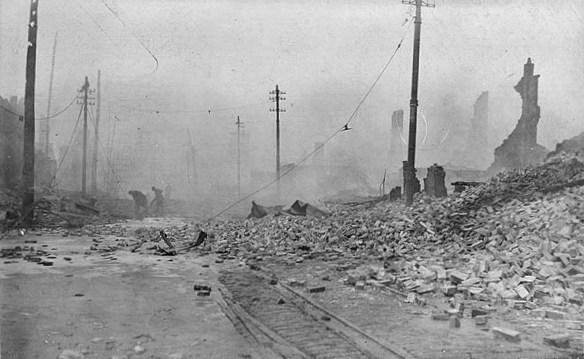Why We Need Standards in Philanthropy
Jenny Love
Published: 02/13/2020

Great Baltimore Fire of 1904, looking West from East Pratt and North Gay Streets. Image source: Historical Society of Maryland website
At 10:48 am on Sunday, February 7, 1904, a fire was reported near the site of the present-day Royal Farms Arena in Baltimore, MD. For the next 30 hours, the fire raged across the city, destroying 1,545 buildings over 70 city blocks. Even after the 1,231 fire fighters called to the scene finally doused it, the fire continued to wreak havoc. It put 35,000 people out of jobs and caused almost $4 billion in damage.
It didn’t have to be that way.
Horse-drawn fire trucks began arriving in Baltimore from Washington and Philadelphia within a few hours of the start of the fire, but most of the firemen could only stand helplessly and watch the blaze take its destructive course. Because no standard existed for fire hoses, fire crews from neighboring cities had no way to attach their water hoses to Baltimore’s hydrants. At the time, American cities used more than 600 different sizes of fire hose couplings. One hundred years later, in 2004, because of national standards initiated after the Baltimore blaze, 43 of the nation’s 50 biggest cities were using at least one standard-sized hose.
Standards are the invisible glue that hold our society together. Without them, cars could have steering wheels and brakes on either side. Every time you rented or bought a new car, you’d have to figure out where everything was located and adjust your driving habits. Without standards, you'd have to carry around a keychain full of converters and adaptors to power all the electronic devices you can’t live without, because every electronics company could use a different current and plug size. Without standards, cities burn to the ground.
Every four years since 2012, AHP has revised our standards manual. I won’t argue that the peril of not agreeing on the definition of cost to raise a dollar equals that of mismatched fire hoses, but data integrity is at the core of every component of healthcare—including philanthropy. Standards in healthcare philanthropy allow us to benchmark our work, measure its impact, and collaborate to magnify our success over time.
The world of healthcare philanthropy has changed a great deal in the past decade. Increasingly, our partners across the healthcare organization expect metrics and data-driven decision making from all areas, including philanthropy. As philanthropy’s role in strategy setting and execution has become more elevated, the standards for reporting have become more important. Data and data integrity have been critical to our profession, whether you are talking to your CFO about production and Generally Accepted Accounting Principles (GAAP) accounting or using data-driven pipeline management to predict the outcome of a capital campaign.
The AHP Standards Manual also shows the power of collaboration. Jibes about camels and committees aside, the old adage that two (or more) heads are better than one holds up to scrutiny. Many heads contributed to the standards we’ve defined, and the result is a comprehensive guide to reporting, including sections on recorded and production revenue, the programmatic recording of gifts, and expense categories.
Our work together to establish standards for our industry has resulted in a document that is stronger and more useful than if any one of us did it alone. By agreeing where we are now, we can move ahead with confidence. We look forward to that journey.
AHP members can download the 2024 Standards Manual for free here.